Data Assimilation of Doppler Wind Lidar for the Extreme Rainfall Event Prediction over Northern Taiwan: A Case Study
Abstract
1. Introduction
2. Overview of the Heavy Rainfall Event
2.1. Synoptic Environments
2.2. Observations
2.2.1. Satellite and Radar Images
2.2.2. Wind Profiles
2.2.3. Accumulated Rainfall
3. Materials and Methods
3.1. Materials
3.1.1. Global Forecast System Data
3.1.2. GEFS
3.1.3. GDAS Observation
3.1.4. Doppler Wind Lidar
3.2. Methods
3.2.1. Model Setting and Assimilation System
3.2.2. Experimental Design
- Control group: hzscl_op (3) = [0.09325, 0.1865, 0.375];
- Experiment group: hzscl_op (3) = [0.046625, 0.09325, 0.1875].
4. Results
4.1. General Weather Analysis
4.1.1. Surface Wind Field, Sea-Level Pressure, and Upper-Air Wind Field
4.1.2. Incremental Influence of the 3D Wind Field
4.2. Accumulated Rainfall
5. Discussion
5.1. Ambient Field
5.1.1. Initial Field Analysis
5.1.2. Forecast Field Analysis
5.2. Accumulated Rainfall
6. Conclusions
- Two independent grids, which featured 15 and 3 km resolutions, were employed for weather forecasting at different scales. The data were then assimilated for application. Hybrid data assimilation was conducted to acquire a large-scale ambient field as the initial and boundary conditions for high-resolution analyses, thus preventing the disturbance between small-scale and large-scale analysis data.
- According to the large-scale analysis results, the short-duration extreme precipitation of the case event was caused by the interaction between the northeast wind incurred by the large-scale frontal movement, and the humid southerly wind generated by Typhoon Choi-wan, and the regional sea-land breeze circulation in northern Taiwan.
- The introduction of the Doppler wind lidar data improved the prediction of the locations and intensity of small-scale extreme precipitation on 4 June because of the improvement in the 3D wind field data within the boundary layer. Because the lidar data corrected the overestimated wind speed and wind directions in the nonassimilated boundary layer data, the wind fields from the estuary of Tamsui and the valley of Keelung were also calibrated with the ground convergence intensity and locations. Therefore, the locations and intensity of the convective systems were corrected.
- The horizontal length scale experiments showed that rainfall forecasts have different results due to wind lidar data at different length scales. Compared with the WRF-GSI_lidar and WRF-GSI_lidar_hzscl experiment, the results indicated that a smaller length scale (hzscl_op) produces a slightly weaker wind speed zone at Taipei Basin when T=0. However, the forecast showed that a smaller length scale generates stronger wind, making the convection tilt southeastward when T=6. Because of such wind field changes, the rainfall area is narrowed away from the XinYi District. From the results of this case, it would be better to set a bigger length scale when assimilating the wind lidar data.
- Compared to the 3 km high-resolution regional forecast results published by the CWB, the forecast by the WRF-GSI model was more accurate in terms of the locations and intensity of extreme precipitation. Regarding the flood in the Xinyi district, the assimilated wind field data reported accumulated rainfall higher than the nonassimilated data by 30 mm. In other words, the model proposed in this study predicted that the accumulated rainfall in the district was improved more than that of the operational model by 15%.
Author Contributions
Funding
Institutional Review Board Statement
Informed Consent Statement
Data Availability Statement
Acknowledgments
Conflicts of Interest
References
- Kharin, V.V.; Zwiers, F.W.; Zhang, X.; Hegerl, G.C. Changes in temperature and precipitation extremes in the IPCC ensemble of global coupled model simulations. J. Clim. 2007, 20, 1419–1444. [Google Scholar] [CrossRef]
- Field, C.B.; Barros, V.; Stocker, T.F.; Dahe, Q.; Jon Dokken, D.; Ebi, K.L.; Mastrandrea, M.D.; Mach, K.J.; Plattner, G.K.; Allen, S.K.; et al. Managing the Risks of Extreme Events and Disasters to Advance Climate Change Adaptation; Cambrdige University Press: Cambridge, UK, 2012; ISBN 9781139177245. [Google Scholar] [CrossRef]
- Ratnam, J.; Behera, S.; Ratna, S.B.; Rajeevan, M.; Yamagata, T. Anatomy of Indian heatwaves. Sci. Rep. 2016, 6, 24395. [Google Scholar] [CrossRef] [PubMed]
- Kumar, V.; Pradhan, P.K.; Sinha, T.; Rao, S.V.B.; Chang, H.-P. Interaction of a low-pressure system, an offshore trough, and mid-tropospheric dry air intrusion: The Kerala Flood of august 2018. Atmosphere 2020, 11, 740. [Google Scholar] [CrossRef]
- AghaKouchak, A.; Chiang, F.; Huning, L.S.; Love, C.A.; Mallakpour, I.; Mazdiyasni, O.; Moftakhari, H.; Papalexiou, S.M.; Ragno, E.; Sadegh, M. Climate extremes and compound hazards in a warming world. Annu. Rev. Earth Planet. Sci. 2020, 48, 519–548. [Google Scholar] [CrossRef]
- World Economic Forum. The Global Risks Report 2021, 16th ed.; World Economic Forum: Geneva, Switzerland, 2021; ISBN 9782940631247. [Google Scholar]
- Aristizábal, E.; García, E.F.; Marín, R.J.; Gómez, F.; Guzmán-Martínez, J. Rainfall-intensity effect on landslide hazard assessment due to climate change in north-western Colombian Andes. Rev. Fac. Ing. Univ. Antioquia. 2022, 103, 1–16. [Google Scholar] [CrossRef]
- Aguilar, E.; Peterson, T.; Obando, P.R.; Frutos, R.; Retana, J.A.; Solera, M.; Soley, J.; García, I.G.; Araujo, R.M.; Santos, A.R.; et al. Changes in precipitation and temperature extremes in Central America and northern South America, 1961–2003. J. Geophys. Res. Atmos. 2005, 110, 1–15. [Google Scholar] [CrossRef]
- Ávila, A.; Justino, F.; Wilson, A.; Bromwich, D.; Amorim, M. Recent precipitation trends, flash floods and landslides in southern Brazil. Environ. Res. Lett. 2016, 11, 114029. [Google Scholar] [CrossRef]
- Espinoza, J.C.; Ronchail, J.; Marengo, J.A.; Segura, H. Contrasting North–South changes in Amazon wet-day and dry-day frequency and related atmospheric features (1981–2017). Clim. Dyn. 2019, 52, 5413–5430. [Google Scholar] [CrossRef]
- Ávila, Á.; Guerrero, F.C.; Escobar, Y.C.; Justino, F. Recent precipitation trends and floods in the Colombian Andes. Water. 2019, 11, 379. [Google Scholar] [CrossRef]
- Avila-Diaz, A.; Justino, F.; Lindemann, D.S.; Rodrigues, J.M.; Ferreira, G.R. Climatological aspects and changes in temperature and precipitation extremes in viçosa-Minas Gerais. An. Acad. Bras. Cienc. 2020, 92, 1–19. [Google Scholar] [CrossRef]
- Cerón, W.L.; Kayano, M.T.; Andreoli, R.V.; Avila-Diaz, A.; Ayes, I.; Freitas, E.D.; Martins, J.A.; Souza, R.A.F. Recent intensification of extreme precipitation events in the La Plata Basin in Southern South America (1981–2018). Atmos. Res. 2021, 249, 105299. [Google Scholar] [CrossRef]
- Seneviratne, S.I.; Zhang, X.; Adnan, M.; Badi, W.; Dereczynski, C.; Di Luca, A.; Ghosh, S.; Iskandar, I.; Kossin, J.; Lewis, S.; et al. Chapter 11: Weather and climate extreme events in a changing climate. In Climate Change 2021: The Physical Science Basis. Contribution of Working Group I to the Sixth Assessment Report of the Intergovernmental Panel on Climate Change; Masson-Delmotte, V.P., Zhai, A., Pirani, S.L., Connors, C., Péan, S., Berger, N., Caud, Y., Chen, L., Goldfarb, M.I., Gomis, M., et al., Eds.; Cambridge University Press: Cambridge, UK, 2021; p. 345. [Google Scholar]
- Donat, M.; Alexander, L.V.; Herold, N.; Dittus, A.J. Temperature and precipitation extremes in century-long gridded observations, reanalyses, and atmospheric model simulations. J. Geophys. Res. Atmos. 2016, 121, 11–174. [Google Scholar] [CrossRef]
- Yang, Y.; Gan, T.Y.; Tan, X. Spatiotemporal changes in precipitation extremes over Canada and their teleconnections to large-scale climate patterns. J. Hydrometeorol. 2019, 20, 275–296. [Google Scholar] [CrossRef]
- Tabari, H. Climate change impact on flood and extreme precipitation increases with water availability. Sci. Rep. 2020, 10, 1–10. [Google Scholar] [CrossRef]
- Khadgarai, S.; Kumar, V.; Pradhan, P.K. The connection between extreme precipitation variability over Monsoon Asia and large-scale circulation patterns. Atmosphere 2021, 12, 1492. [Google Scholar] [CrossRef]
- Balmaceda-Huarte, R.; Olmo, M.E.; Bettolli, M.L.; Poggi, M.M. Evaluation of multiple reanalyses in reproducing the spatio-temporal variability of temperature and precipitation indices over southern South America. Int. J. Climatol. 2021, 41, 5572–5595. [Google Scholar] [CrossRef]
- Vicente-Serrano, S.M.; García-Herrera, R.; Peña-Angulo, D.; Tomas-Burguera, M.; Domínguez-Castro, F.; Noguera, I.; Calvo, N.; Murphy, C.; Nieto, R.; Gimeno, L.; et al. Do CMIP models capture long-term observed annual precipitation trends? Clim. Dyn. 2021, 58, 2825–2842. [Google Scholar] [CrossRef]
- Zhu, Z.; Li, T. A new paradigm for continental U.S. summer rainfall variability: Asia-North America teleconnection. J. Clim. 2016, 29, 7313–7327. [Google Scholar] [CrossRef]
- Sánchez-Benítez, A.; García-Herrera, R.; Vicente-Serrano, S.M. Revisiting precipitation variability, trends and drivers in the Canary Islands. Int. J. Climatol. 2017, 37, 3565–3576. [Google Scholar] [CrossRef]
- Gao, L.; Huang, J.; Chen, X.; Chen, Y.; Liu, M. Contributions of natural climate changes and human activities to the trend of extreme precipitation. Atmos. Res. 2018, 205, 60–69. [Google Scholar] [CrossRef]
- Zhou, X.; Huang, G.; Wang, X.; Cheng, G. Future Changes in Precipitation Extremes Over Canada: Driving Factors and Inherent Mechanism. J. Geophys. Res. Atmos. 2018, 123, 5783–5803. [Google Scholar] [CrossRef]
- Krishnan, R.; Sanjay, J.; Gnanaseelan, C.; Mujumdar, M.; Kulkarni, A.; Chakraborty, S. Assessment of Climate Change over the Indian Region: A Report of the Ministry of Earth Sciences (MOES), Government of India; Springer Nature: Basingstoke, UK, 2020; p. 226. [Google Scholar]
- Chadwick, R.; Good, P.; Martin, G.; Rowell, D.P. Large rainfall changes consistently projected over substantial areas of tropical land. Nat. Clim. Chang. 2016, 6, 177–181. [Google Scholar] [CrossRef]
- Benjamin, S.G.; Brown, J.M.; Brunet, G.; Lynch, P.; Saito, K.; Schlatter, T.W. 100 Years of progress in forecasting and NWP applications. Meteorol. Monogr. 2019, 59, 13.1–13.67. [Google Scholar] [CrossRef]
- Houze, R.A. 100 Years of research on mesoscale convective systems. Meteorol. Monogr. 2018, 59, 17.1–17.54. [Google Scholar] [CrossRef]
- Prein, A.F.; Langhans, W.; Fosser, G.; Ferrone, A.; Ban, N.; Goergen, K.; Keller, M.; Tölle, M.; Gutjahr, O.; Feser, F.; et al. A review on regional convection-permitting climate modeling: Demonstrations, prospects, and challenges. Rev. Geophys. 2015, 53, 323–361. [Google Scholar] [CrossRef]
- Peters, K.; Hohenegger, C.; Klocke, D. Different Representation of Mesoscale Convective Systems in Convection-Permitting and Convection-Parameterizing NWP Models and Its Implications for Large-Scale Forecast Evolution. Atmosphere 2019, 10, 503. [Google Scholar] [CrossRef]
- Zhang, F.; Odins, A.M.; Nielsen-Gammon, J.W. Mesoscale predictability of an extreme warm-season precipitation event. Weather Forecast 2006, 21, 149–166. [Google Scholar] [CrossRef]
- Kato, T.; Aranami, K. Formation factors of 2004 Niigata-Fukushima and Fukui heavy rainfalls and problems in the predictions using a cloud-resolving model. Sci. Online Lett. Atmos. 2005, 1, 1–4. [Google Scholar] [CrossRef]
- Done, J.; Davis, C.A.; Weisman, M. The next-generation of NWP: Explicit forecasts of convection using the Weather Research and Forecasting (WRF) model. Atmos. Sci. Lett. 2004, 5, 110–117. [Google Scholar] [CrossRef]
- Hristova-Veleva, S.; Zhang, S.Q.; Turk, F.J.; Haddad, Z.S.; Sawaya, R.C. Assimilation of DAWN Doppler wind lidar data during the 2017 convective processes experiment (CPEX): Impact on precipitation and flow structure. Atmos. Meas. Tech. 2021, 14, 3333–3350. [Google Scholar] [CrossRef]
- Kawabata, T.; Seko, H.; Saito, K.; Kuroda, T.; Tamiya, K.; Tsuyuki, T.; Honda, Y.; Wakazuki, Y. An assimilation and forecasting experiment of the Nerima heavy rainfall with a cloud-resolving nonhydrostatic 4-dimensional variational data assimilation system. J. Meteor. Soc. Jpn. 2007, 85, 255–276. [Google Scholar] [CrossRef]
- Rennie, S.J.; Dance, S.L.; Illingworth, A.J.; Ballard, S.P.; Simonin, D. 3D-Var assimilation of insect-derived Doppler radar radial winds in convective cases using a high-resolution model. Mon. Weather Rev. 2011, 139, 1148–1163. [Google Scholar] [CrossRef]
- Tang, W.; Chan, P.W.; Haller, G. Lagrangian Coherent structure analysis of terminal winds detected by lidar. part I: Turbulence structures. J. Appl. Meteorol. Clim. 2011, 50, 325–338. [Google Scholar] [CrossRef]
- Zhang, L.; Pu, Z. Four-dimensional assimilation of multitime wind profiles over a single station and numerical simulation of a mesoscale convective system observed during IHOP_2002. Mon. Weather Rev. 2011, 139, 3369–3388. [Google Scholar] [CrossRef][Green Version]
- Huang, X.-Y.; Xiao, Q.; Barker, D.M.; Zhang, X.; Michalakes, J.; Huang, W.; Henderson, T.; Bray, J.; Chen, Y.; Ma, Z.; et al. Four-dimensional variational data assimilation for WRF: Formulation and preliminary results. Mon. Weather Rev. 2009, 137, 299–314. [Google Scholar] [CrossRef]
- Li, L.; Shao, A.; Zhang, K.; Ding, N.; Chan, P.-W. Low-Level wind shear characteristics and lidar-based alerting at Lanzhou Zhongchuan International Airport, China. J. Meteorol. Res. 2020, 34, 633–645. [Google Scholar] [CrossRef]
- Banta, R.M.; Olivier, L.D.; Gudiksen, P.H.; Lange, R. Implications of small-scale flow features to modeling dispersion over complex terrain. J. Appl. Meteor. 1996, 35, 330–342. [Google Scholar] [CrossRef][Green Version]
- Shun, C.M.; Chan, P.W. Applications of an infrared Doppler lidar in detection of wind shear. J. Atmos. Oceanic Technol. 2008, 25, 637–655. [Google Scholar] [CrossRef]
- Wu, C.-S.; Lin, Y.-F.; Lee, C.-Y. Application of wind profiler by laser. Q. J. Meteorol. 2016, 228, 1–7. (In Chinese) [Google Scholar]
- Zhang, H.; Wu, S.; Wang, Q.; Liu, B.; Yin, B.; Zhai, X. Airport low-level wind shear lidar observation at Beijing Capital International Airport. Infrared Phys. Technol. 2019, 96, 113–122. [Google Scholar] [CrossRef]
- Thobois, L.; Cariou, J.P.; Gultepe, I. Review of lidar-based applications for aviation weather. Pure Appl. Geophys. 2019, 176, 1959–1976. [Google Scholar] [CrossRef]
- Kawabata, T.; Iwai, H.; Seko, H.; Shoji, Y.; Saito, K.; Ishii, S.; Mizutani, K. Cloud-Resolving 4D-Var assimilation of doppler wind lidar data on a meso-gamma-scale convective system. Mon. Weather Rev. 2014, 142, 4484–4498. [Google Scholar] [CrossRef]
- Skamarock, W.C.; Klemp, J.B.; Dudhia, J.; Gill, D.O.; Barker, D.M.; Duda, M.G.; Huang, X.-Y.; Wang, W.; Powers, J.G. A Description of the Advanced Research WRF Version 3 (No. NCAR/TN-475+STR); University Corporation for Atmospheric Research: Boulder, CO, USA, 2008; p. 113. [Google Scholar] [CrossRef]
- Kleist, D.T.; Parrish, D.F.; Derber, J.C.; Treadon, R.; Wu, W.-S.; Lord, S. Introduction of the GSI into the NCEP global data assimilation system. Weather Forecast 2009, 24, 1691–1705. [Google Scholar] [CrossRef]
- Kanamitsu, M. Description of the NMC Global data assimilation and forecast system. Weather Forecast 1989, 4, 335–342. [Google Scholar] [CrossRef]
- Kalnay, E.; Kanamitsu, M.; Baker, W.E. Global numerical weather prediction at the National Meteorological Center. Bull. Am. Meteor. Soc. 1990, 71, 1410–1428. [Google Scholar] [CrossRef]
- Harris, L.; Chen, X.; Putman, W.; Zhou, L.; Chen, J.-H. A Scientific Description of the GFDL Finite-Volume Cubed-Sphere Dynamical Core; Geophysical Fluid Dynamics Laboratory: Princeton, NJ, USA, 2021; p. 109. [Google Scholar] [CrossRef]
- Toth, Z.; Kalnay, E. Ensemble forecasting at NMC: The generation of perturbations. Bull. Am. Meteor. Soc. 1993, 74, 2317–2330. [Google Scholar] [CrossRef]
- Whitaker, J.S.; Hamill, T.M.; Wei, X.; Song, Y.; Toth, Z. Ensemble data assimilation with the NCEP global forecast system. Mon. Weather Rev. 2008, 136, 463–482. [Google Scholar] [CrossRef]
- Zhou, X.; Zhu, Y.; Hou, D.; Kleist, D. Comparison of the ensemble transform and the ensemble Kalman Filter in the NCEP global ensemble forecast system. Weather Forecast 2016, 31, 2058–2074. [Google Scholar] [CrossRef]
- Zhou, X.; Zhu, Y.; Hou, D.; Luo, Y.; Peng, J.; Wobus, R. Performance of the New NCEP global ensemble forecast system in a parallel experiment. Weather Forecast 2017, 32, 1989–2004. [Google Scholar] [CrossRef]
- Benjamin, S.G.; Weygandt, S.S.; Brown, J.M.; Hu, M.; Alexander, C.R.; Smirnova, T.G.; Olson, J.B.; James, E.P.; Dowell1, D.C.; Grell, G.A.; et al. A North American hourly assimilation and model forecast cycle: The rapid refresh. Mon. Weather Rev. 2016, 144, 1669–1694. [Google Scholar] [CrossRef]
- Tao, W.-K.; Simpson, J.; McCumber, M. An ice–water saturation adjustment. Mon. Weather Rev. 1989, 117, 231–235. [Google Scholar] [CrossRef]
- Tao, W.-K.; Wu, D.; Lang, S.; Chern, J.-D.; Peters-Lidard, C.; Fridlind, A.; Matsui, T. High-resolution NU-WRF simulations of a deep convective-precipitation system during MC3E: Further improvements and comparisons between Goddard microphysics schemes and observations. J. Geophys. Res. Atmos. 2016, 121, 1278–1305. [Google Scholar] [CrossRef] [PubMed]
- Iacono, M.J.; Delamere, J.S.; Mlawer, E.J.; Shephard, M.W.; Clough, S.A.; Collins, W.D. Radiative forcing by long–lived greenhouse gases: Calculations with the AER radiative transfer models. J. Geophys. Res. 2008, 113, D13103. [Google Scholar] [CrossRef]
- Nakanishi, M.; Niino, H. An improved Mellor–Yamada level 3 model: Its numerical stability and application to a regional prediction of advection fog. Bound. Layer Meteor. 2006, 119, 397–407. [Google Scholar] [CrossRef]
- Nakanishi, M.; Niino, H. Development of an improved turbulence closure model for the atmospheric boundary layer. J. Meteor. Soc. Jpn. 2009, 87, 895–912. [Google Scholar] [CrossRef]
- Pleim, J.E.; Xiu, A. Development and testing of a surface flux and planetary boundary layer model for application in mesoscale models. J. Appl. Meteor. 1995, 34, 16–32. [Google Scholar] [CrossRef]
- Pleim, J.E.; Xiu, A. Development of a land surface model. Part II: Data assimilation. J. Appl. Meteor. 2003, 42, 1811–1822. [Google Scholar] [CrossRef]
- Han, J.; Pan, H.-L. Revision of convection and vertical diffusion schemes in the NCEP global forecast system. Weather Forecast 2011, 26, 520–533. [Google Scholar] [CrossRef]
- Pleim, J.E. A Combined local and nonlocal closure model for the atmospheric boundary layer. Part I: Model description and testing. J. Appl. Meteor. Climatol. 2007, 46, 1383–1395. [Google Scholar] [CrossRef]
- Madala, S.; Srinivas, C.V.; Satyanarayana, A.N.V. Performance of WRF for simulation of mesoscale meteorological characteristics for air quality assessment over tropical coastal city, Chennai. Pure Appl. Geophys. 2018, 175, 501–518. [Google Scholar] [CrossRef]
- Cooperman, A.; Dam, C.P.; Zack, J.; Chen, S.-H.; MacDonald, C. Improving Short-Term Wind Power Forecast. Through Measurements and Modeling of the Tehachapi Wind Resource Area; Publication Number: CEC-500-2018-002; California Energy Commission: Sacramento, CA, USA, 2018; p. 77. [Google Scholar]
- Wu, W.-S.; Purser, R.J.; Parrish, D.F. Three-dimensional variational analysis with spatially inhomogeneous covariances. Mon. Weather Rev. 2002, 130, 2905–2916. [Google Scholar] [CrossRef]
- Purser, R.J.; Wu, W.-S.; Parrish, D.F.; Roberts, N.M. Numerical aspects of the application of recursive filters to variational statistical analysis. Part I: Spatially homogeneous and isotropic Gaussian covariances. Mon. Weather Rev. 2003, 131, 1524–1535. [Google Scholar] [CrossRef]
- Liu, Y.-A.; Huang, H.-L.A.; Gao, W.; Lim, A.H.N.; Liu, C.; Shi, R. Tuning of background error statistics through sensitivity experiments and its impact on typhoon forecast. J. Appl. Remote Sens. 2015, 9, 96051. [Google Scholar] [CrossRef]
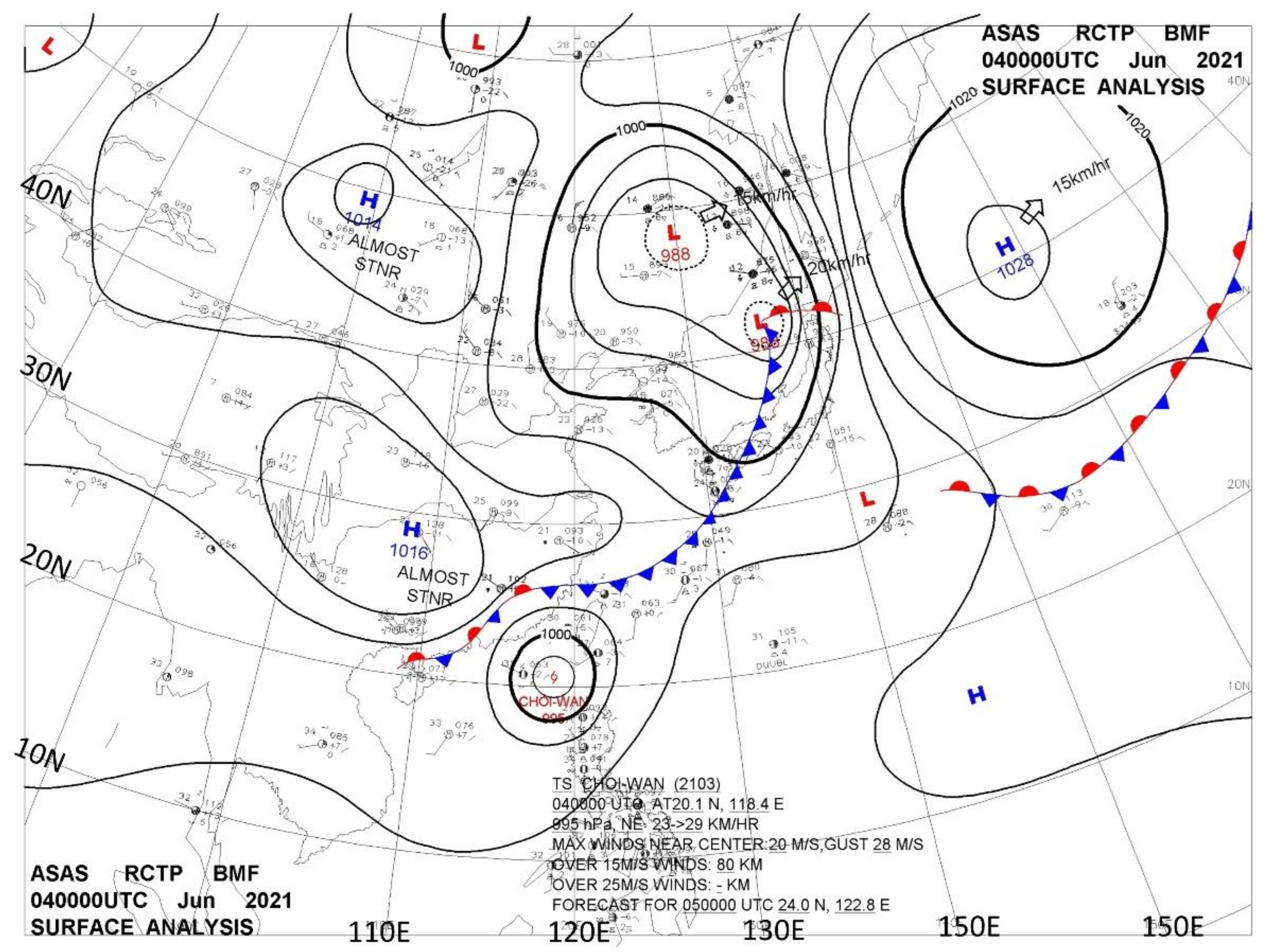
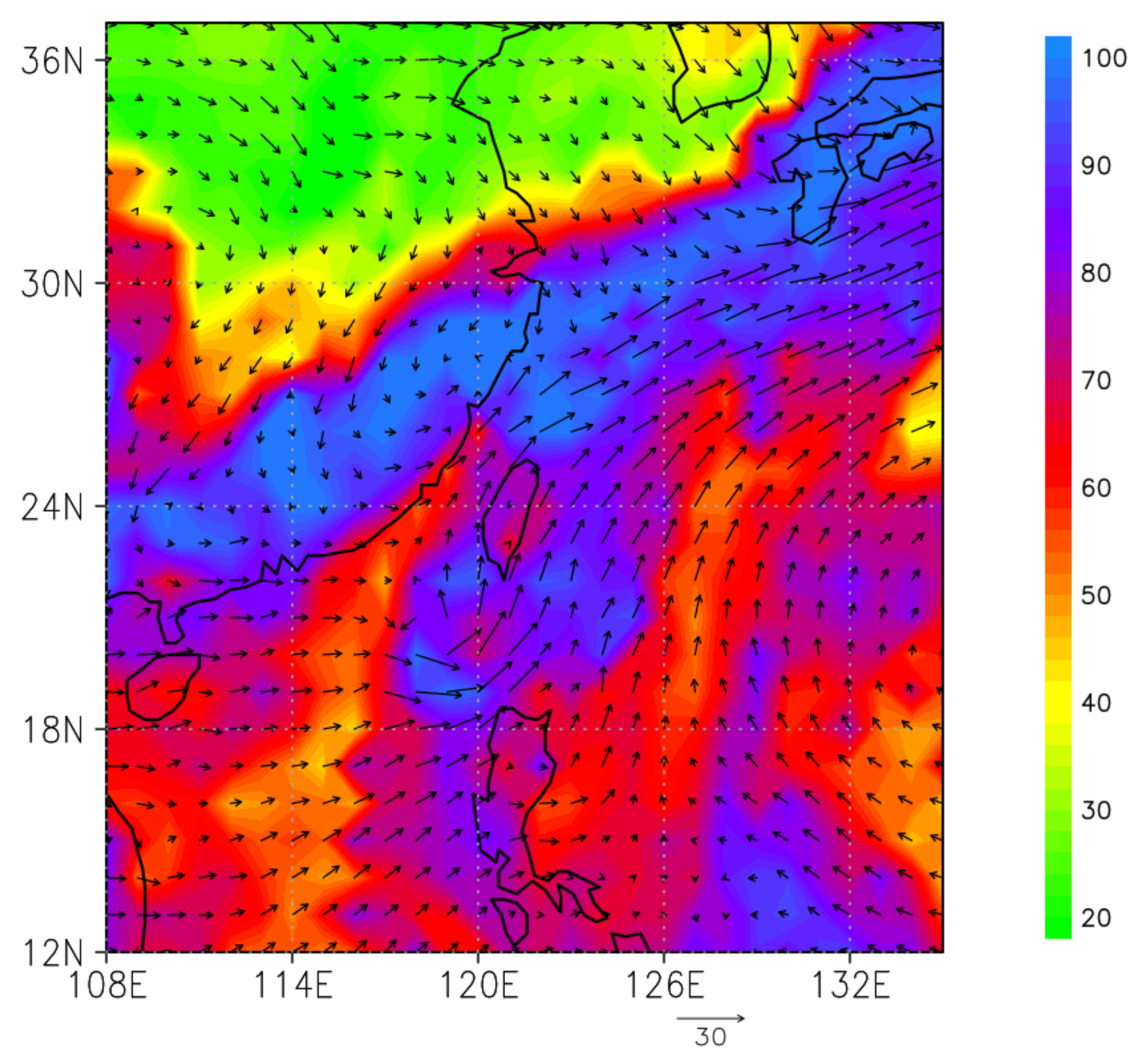
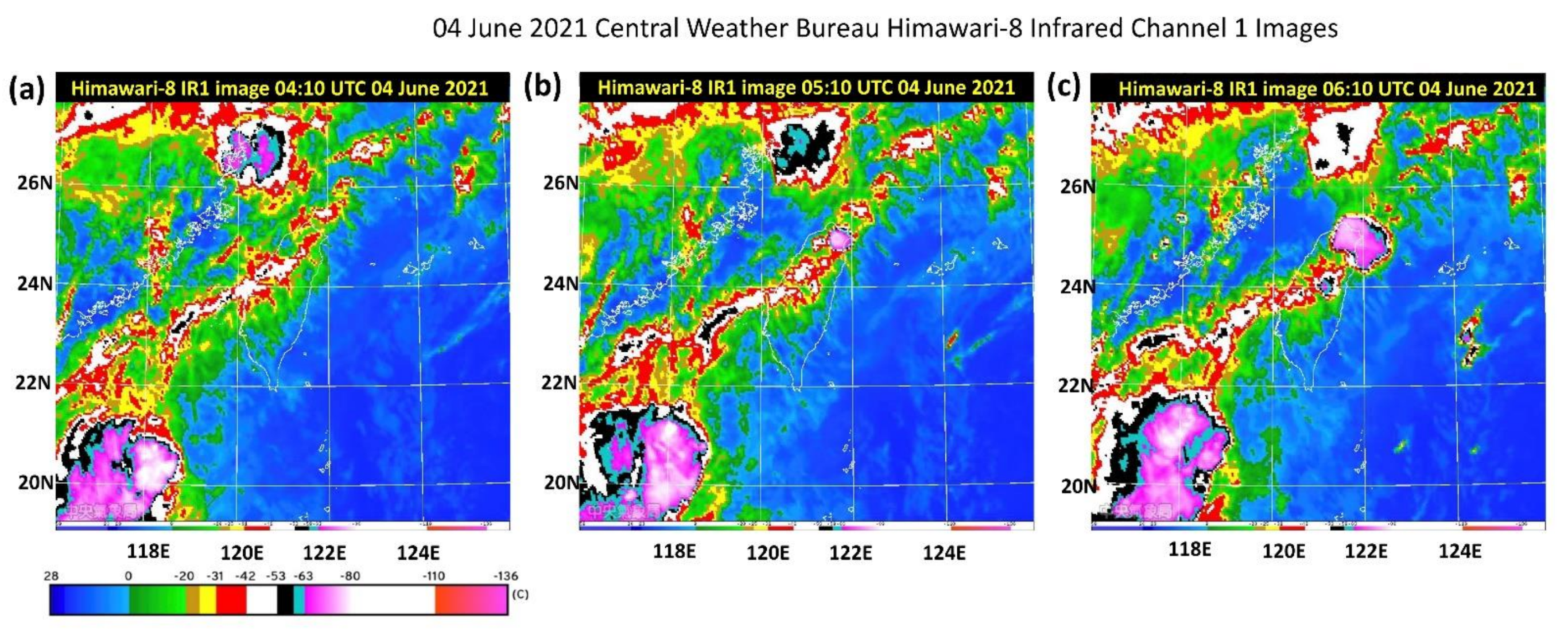

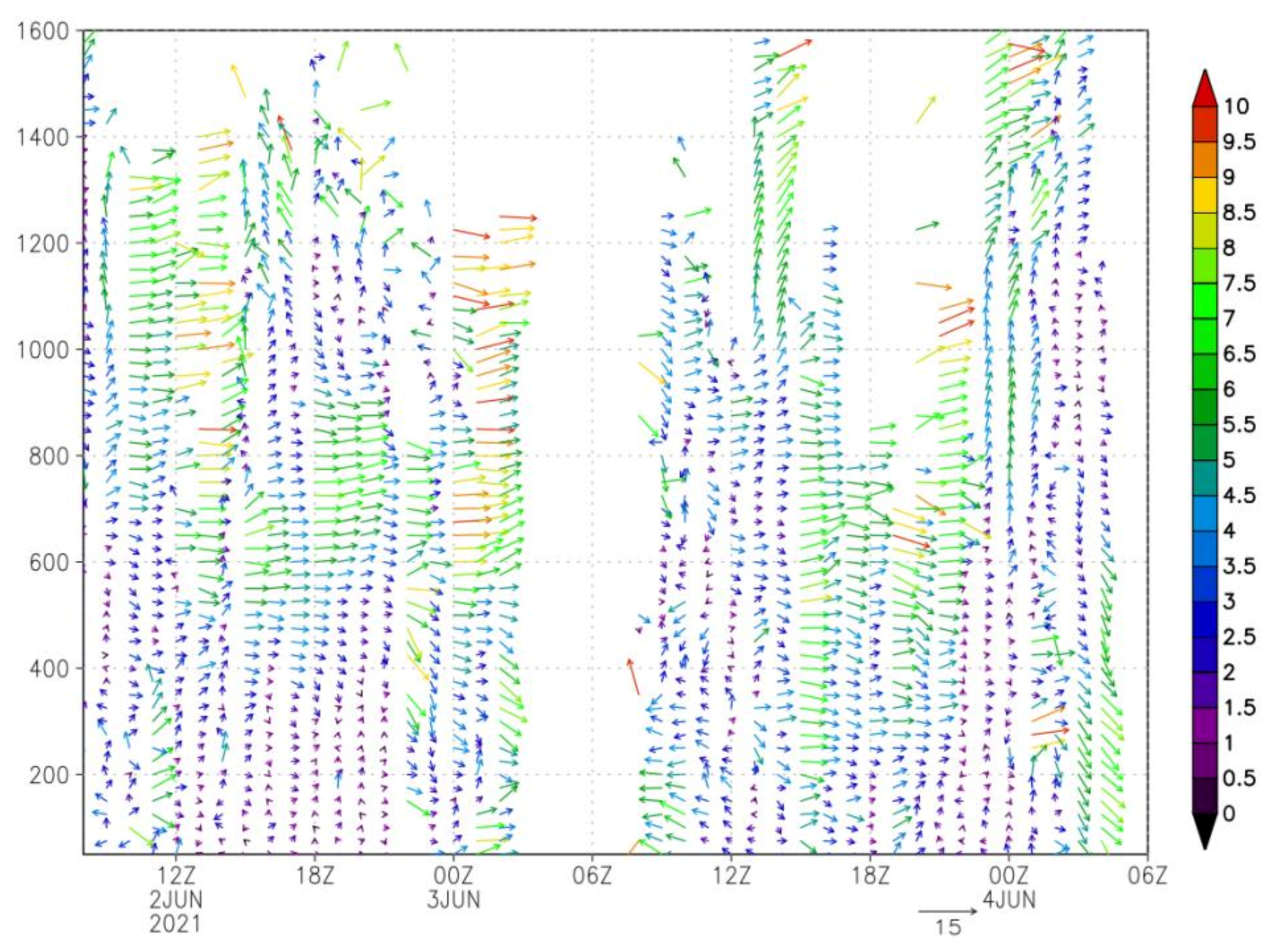
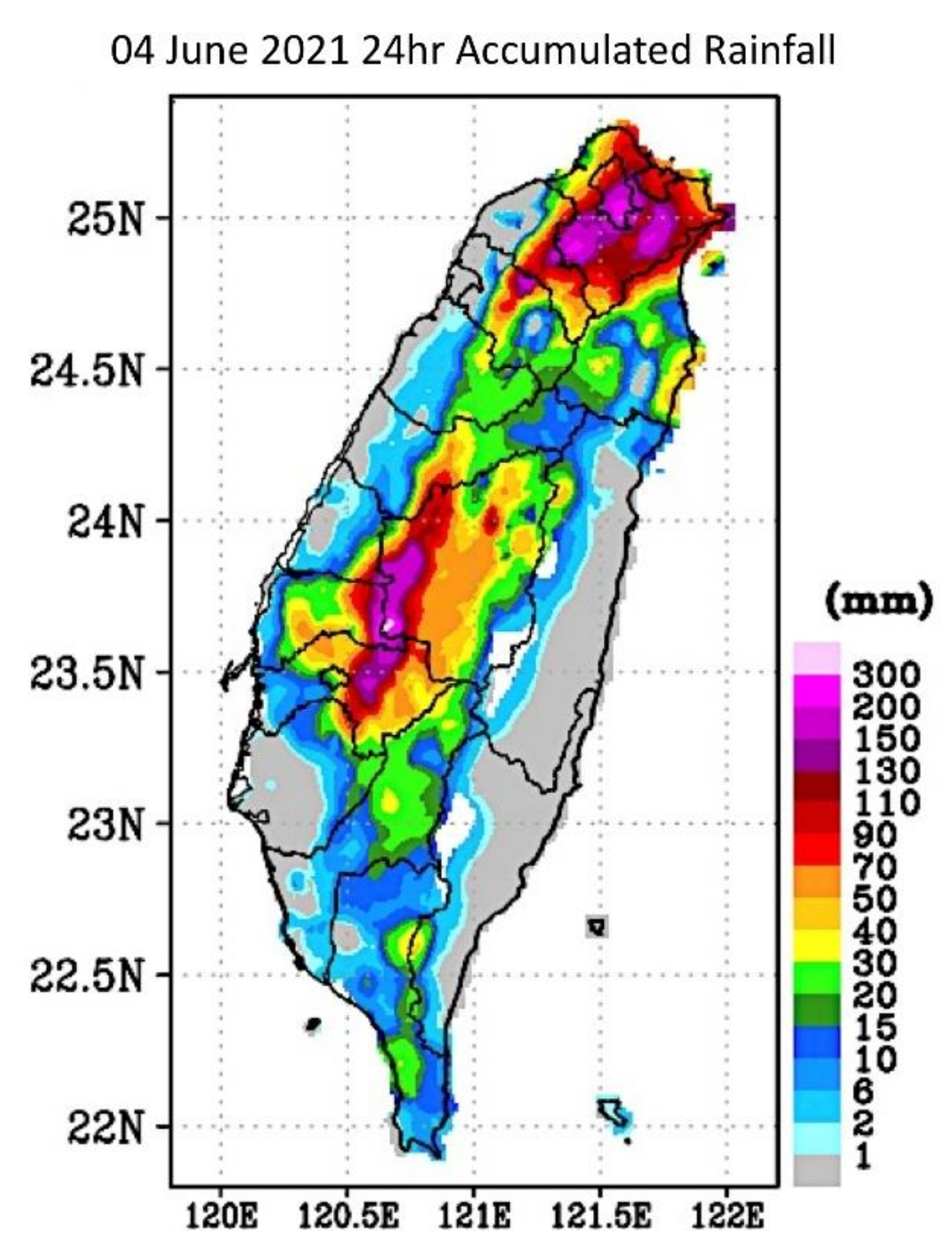
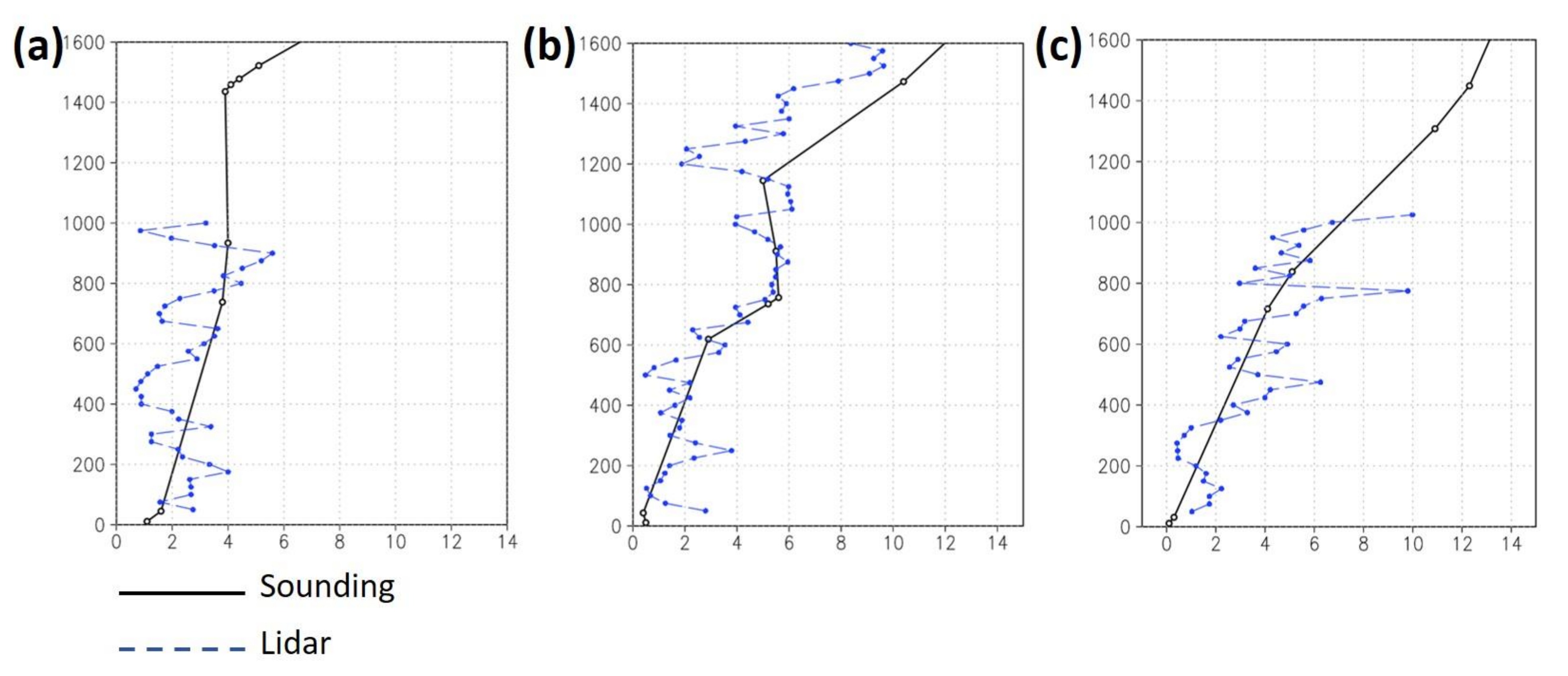

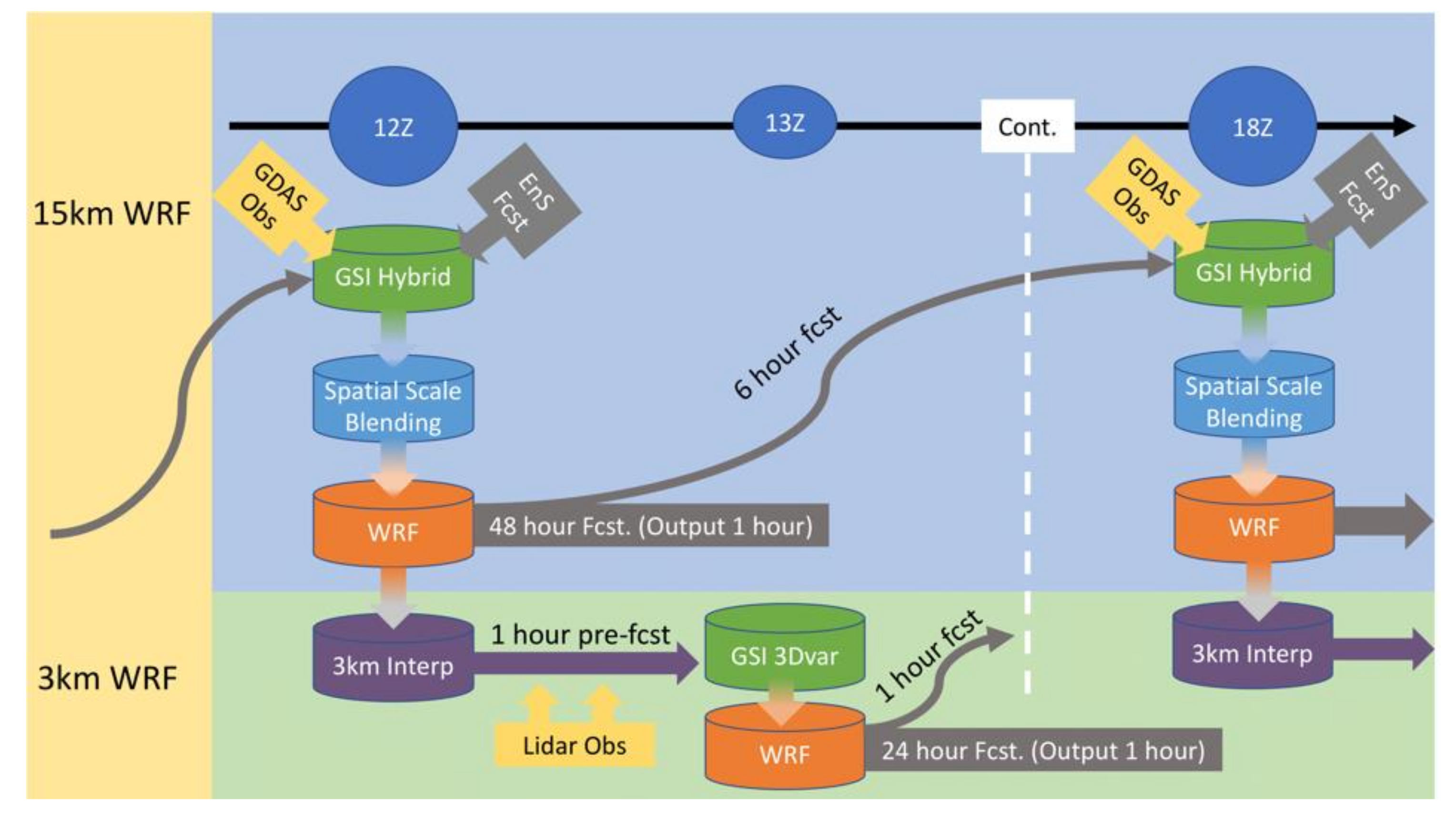
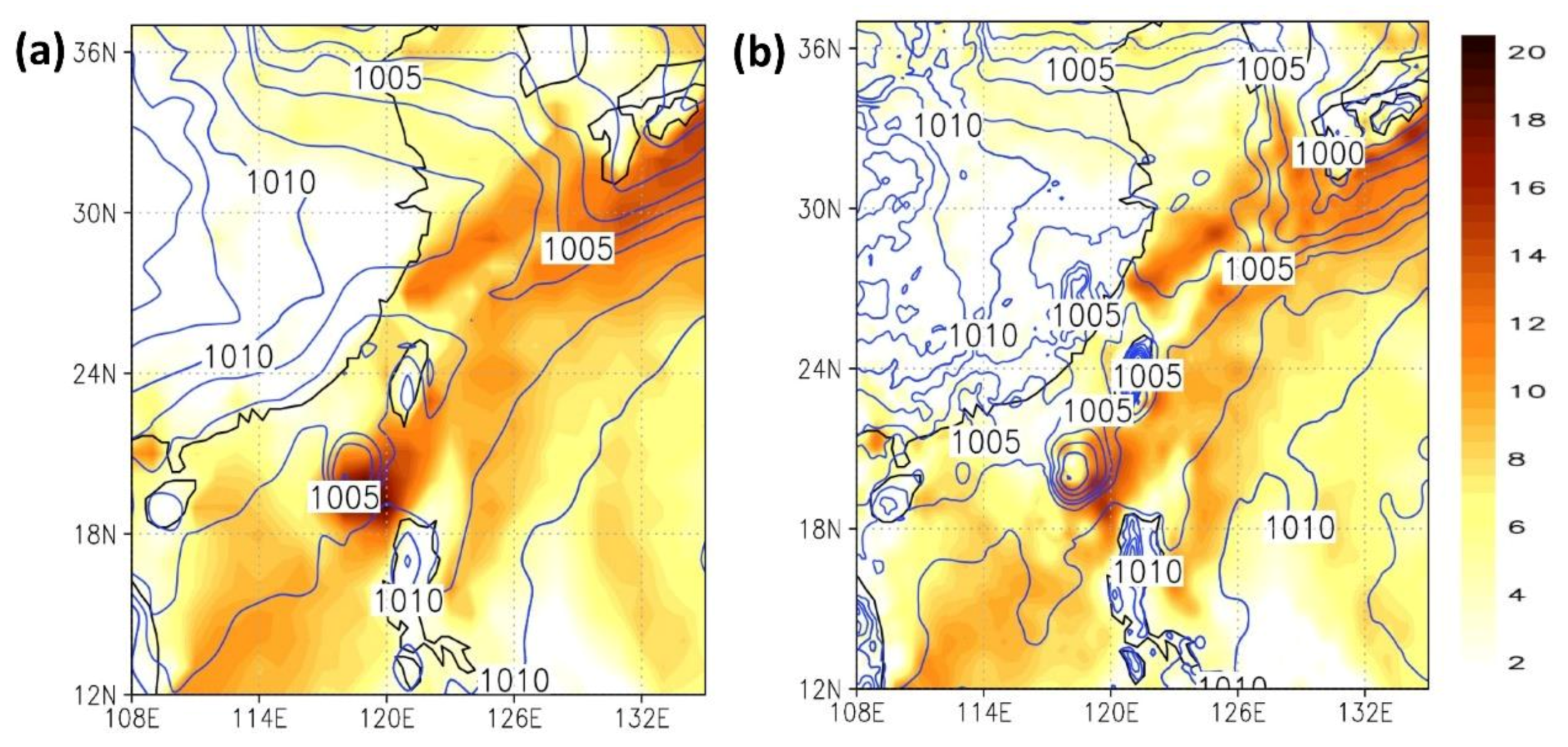
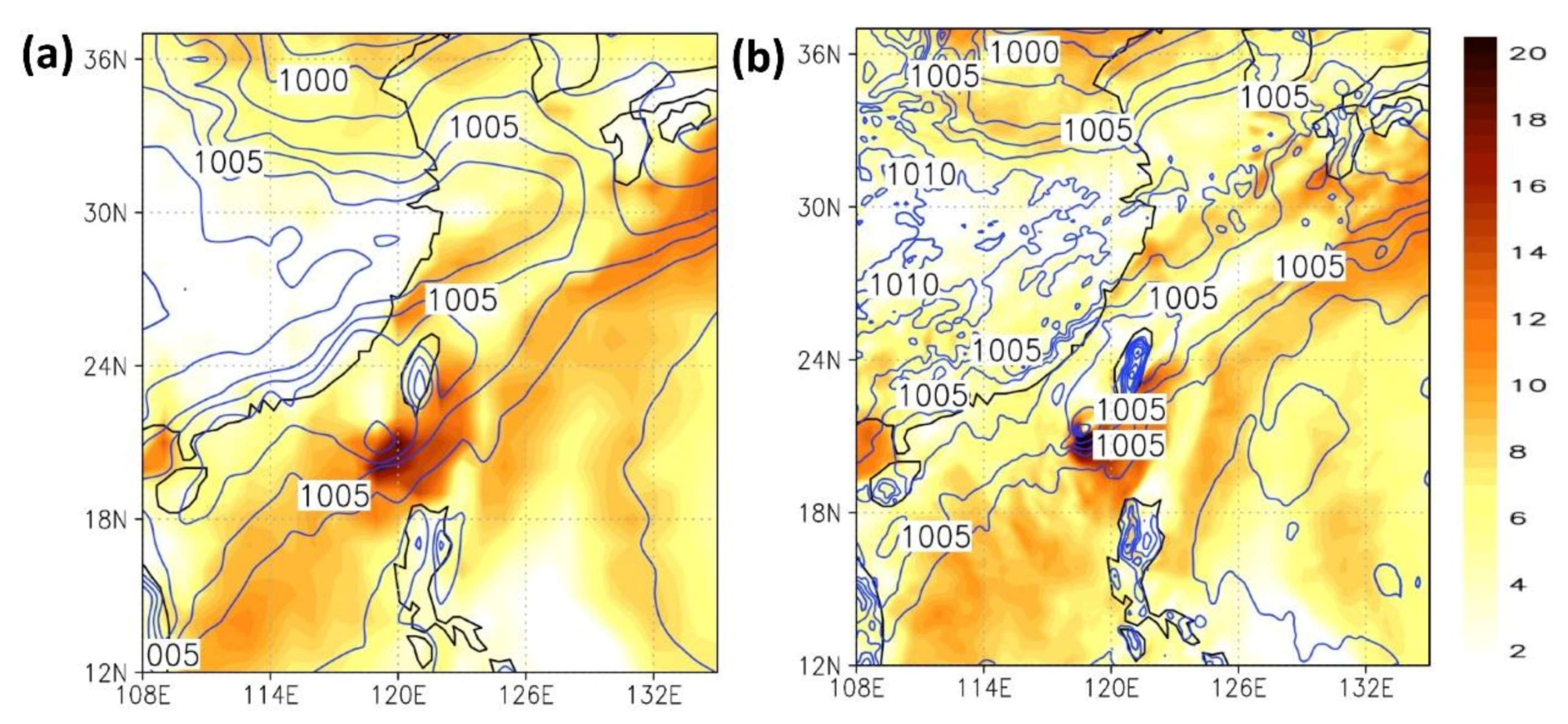
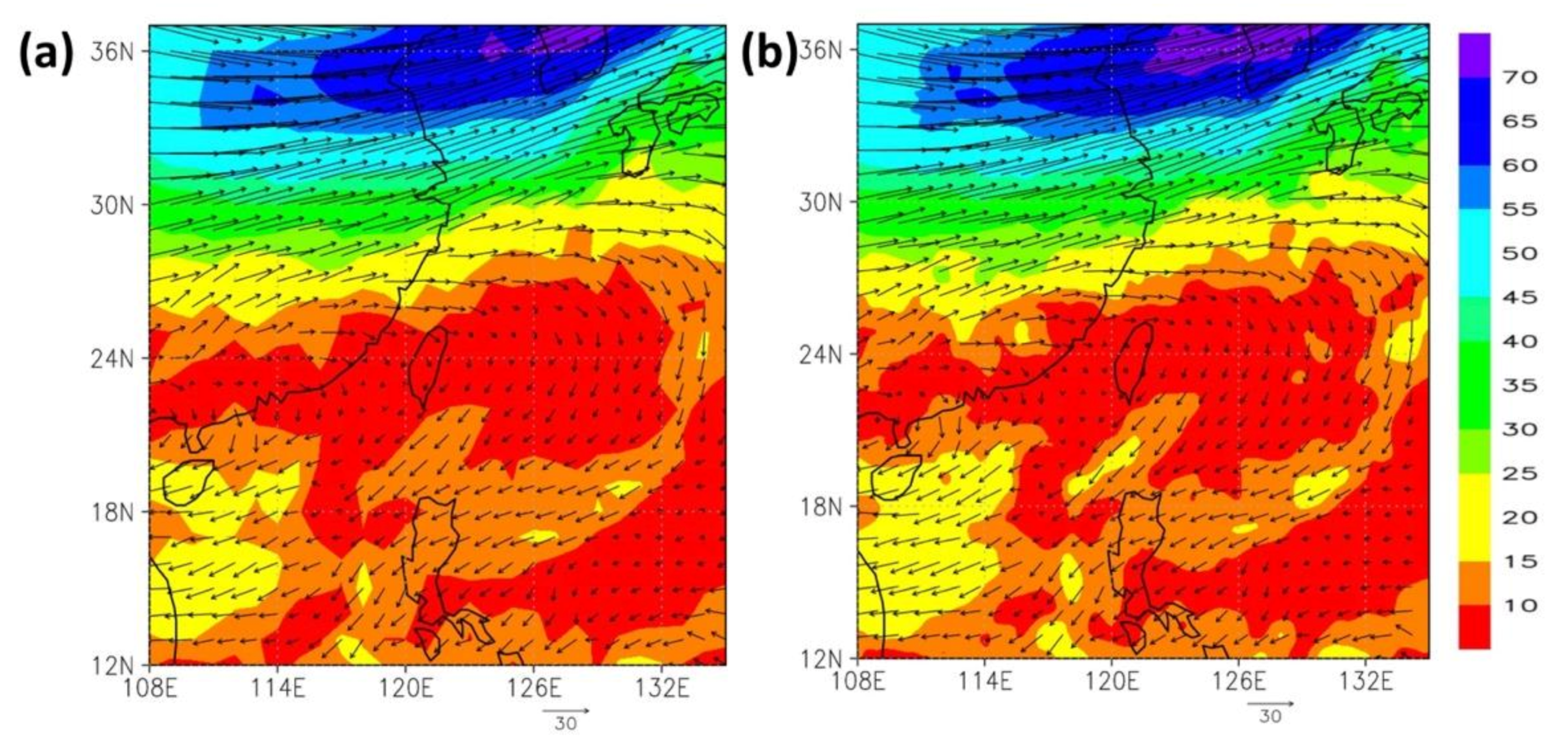
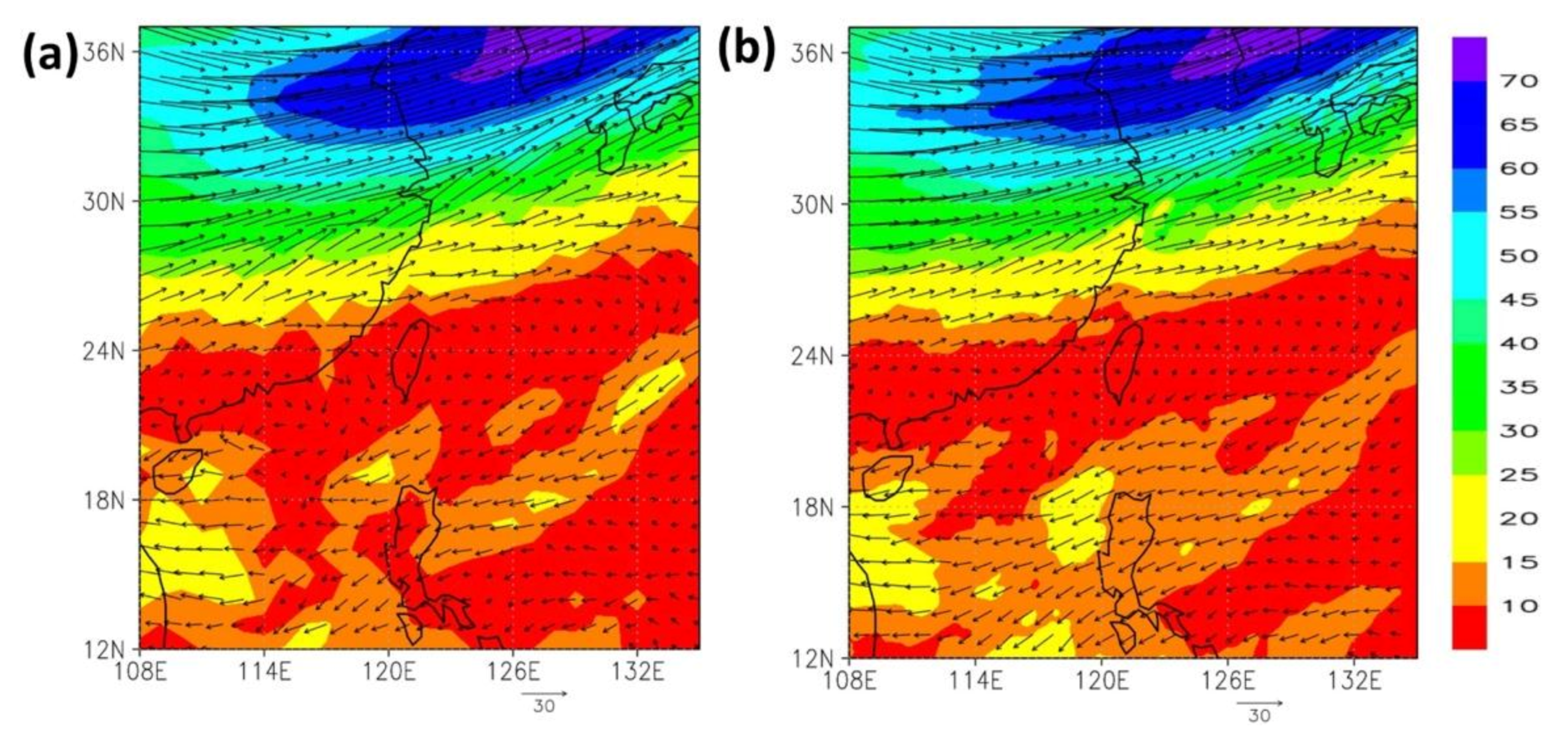
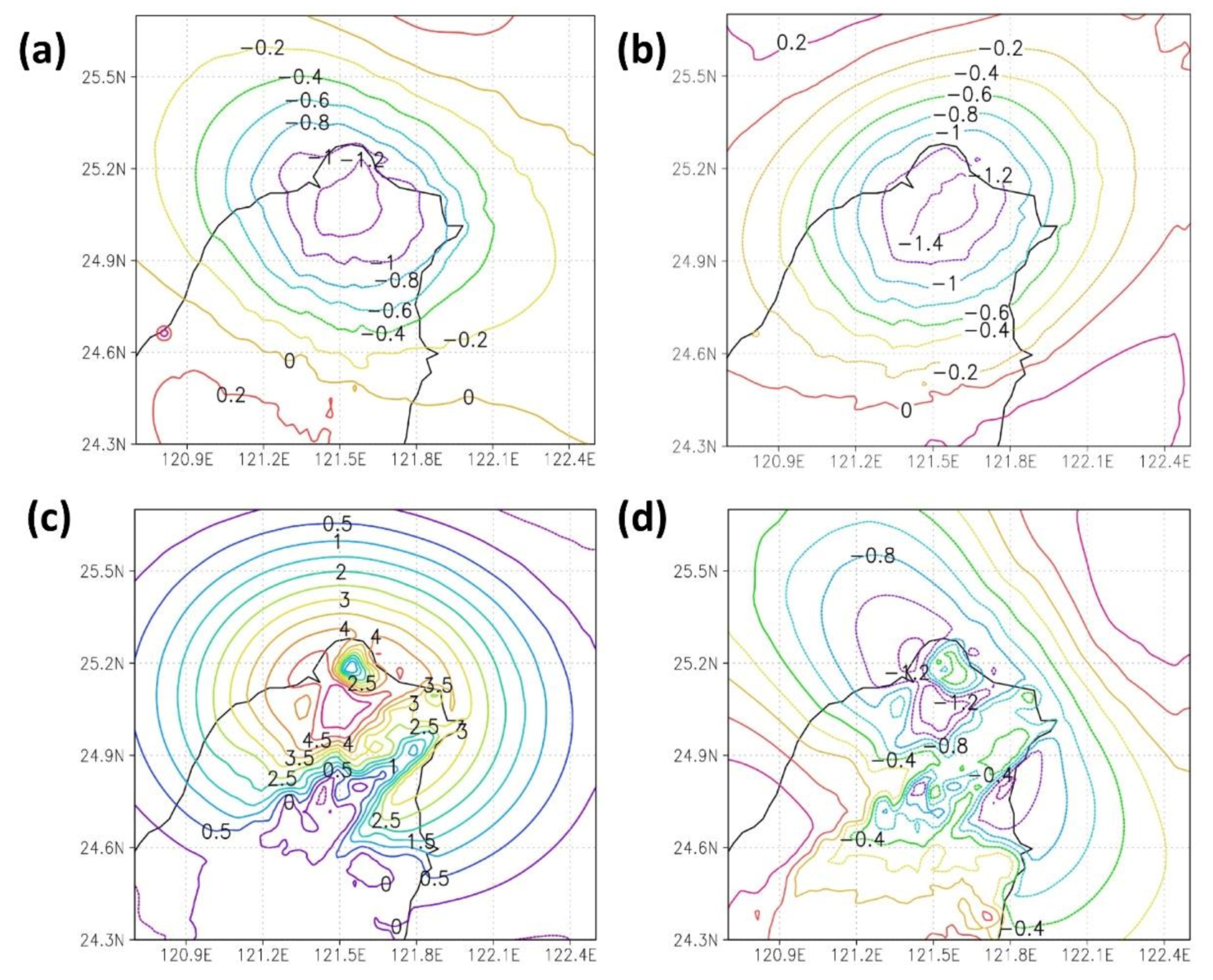
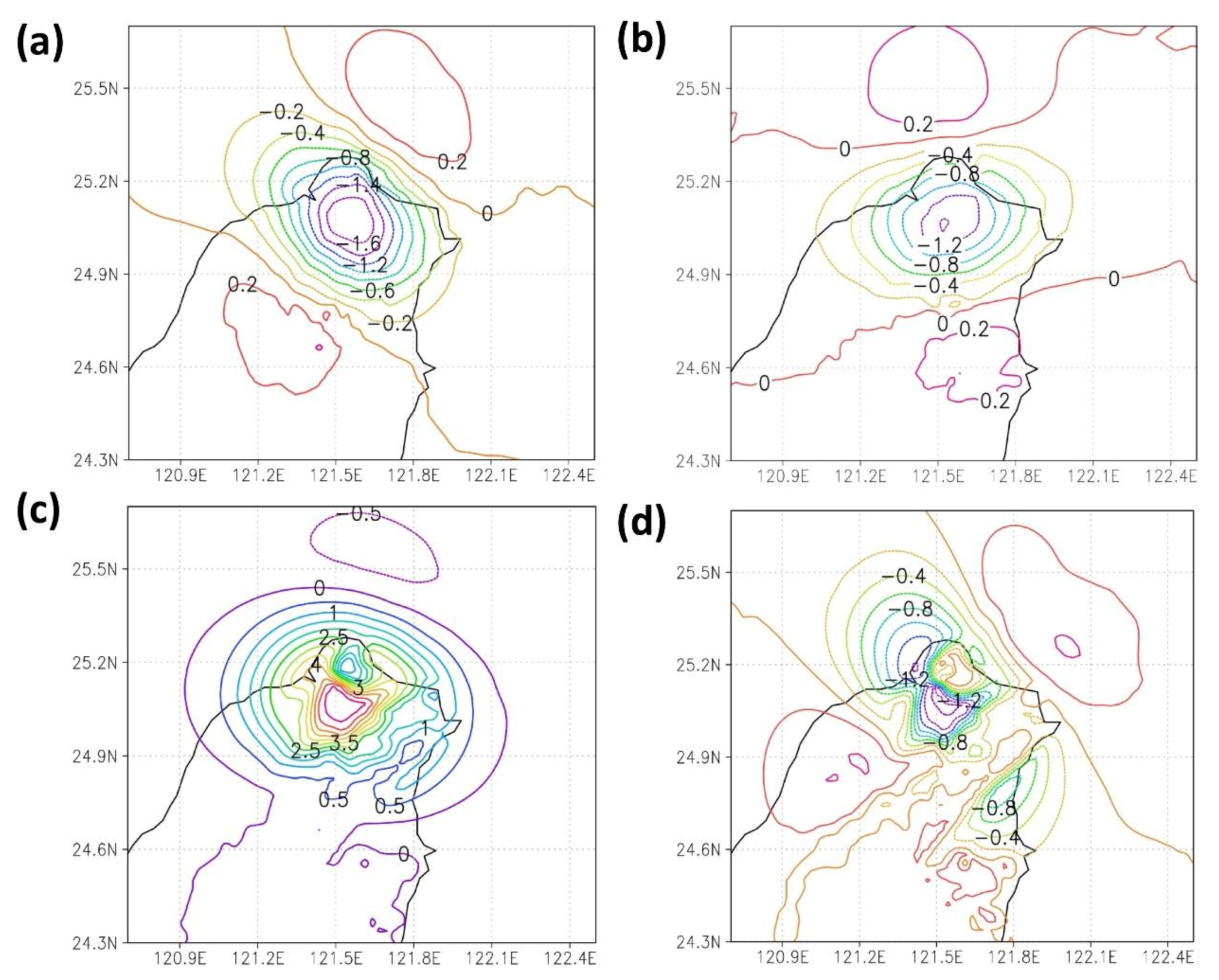
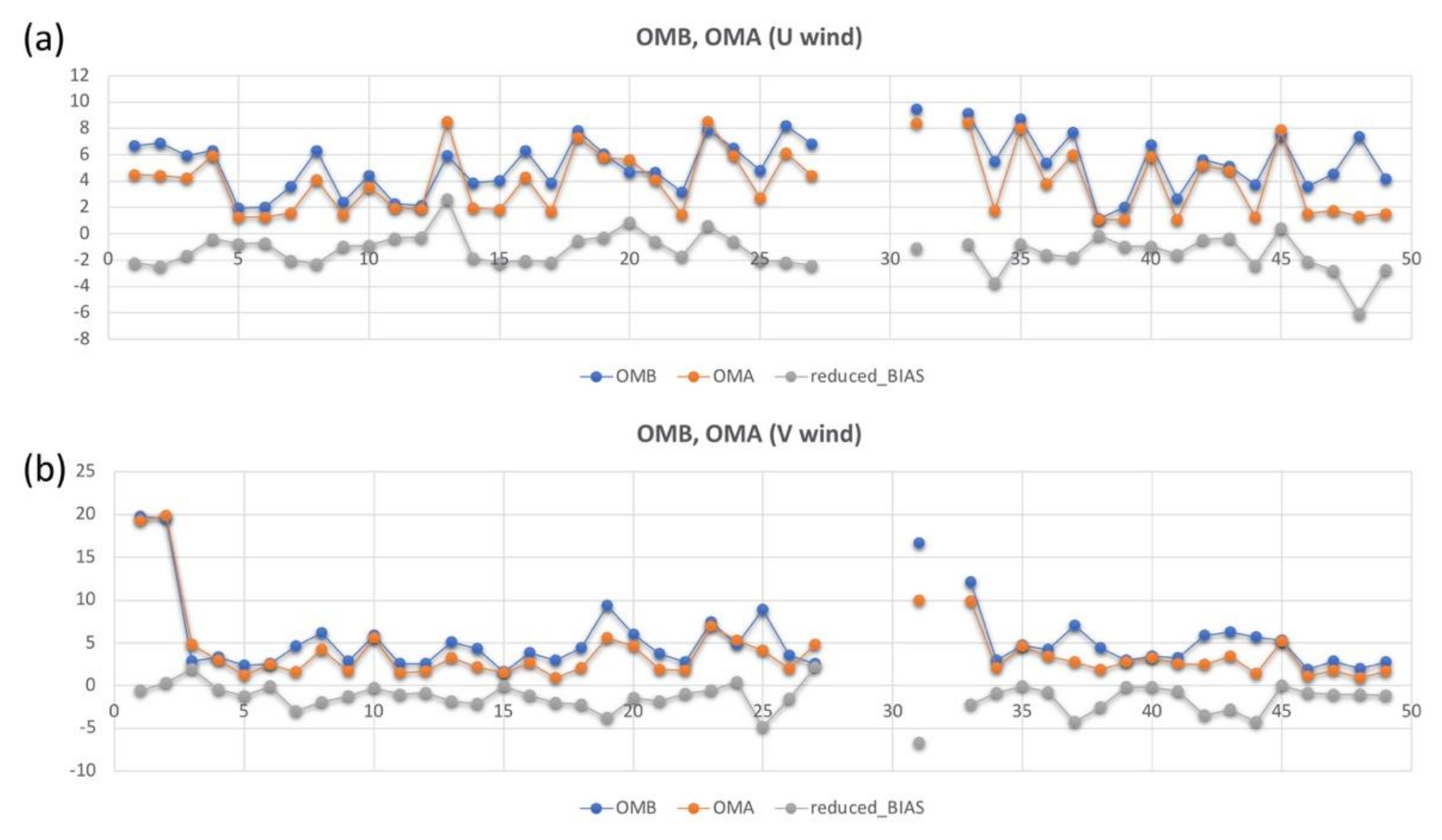

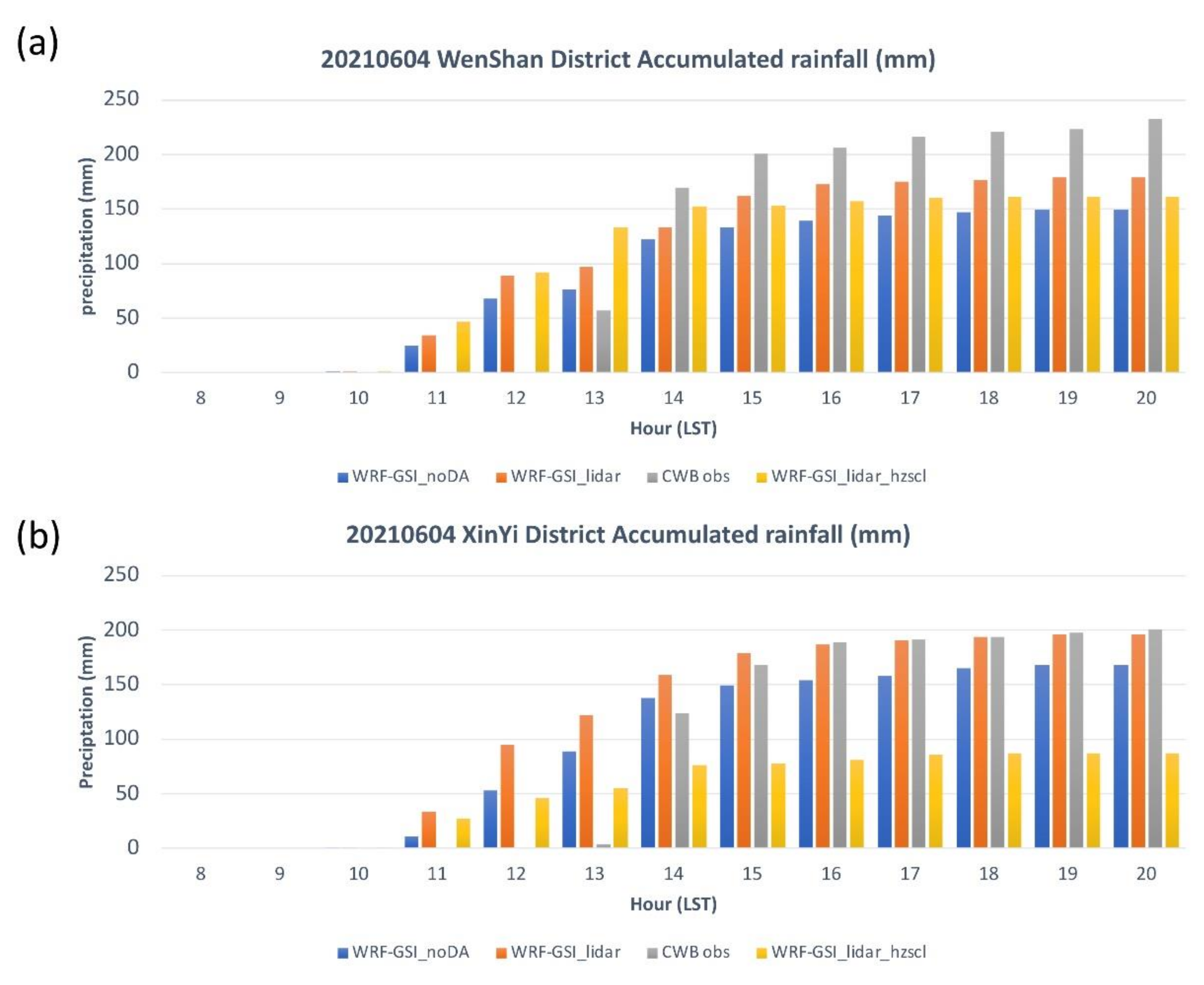
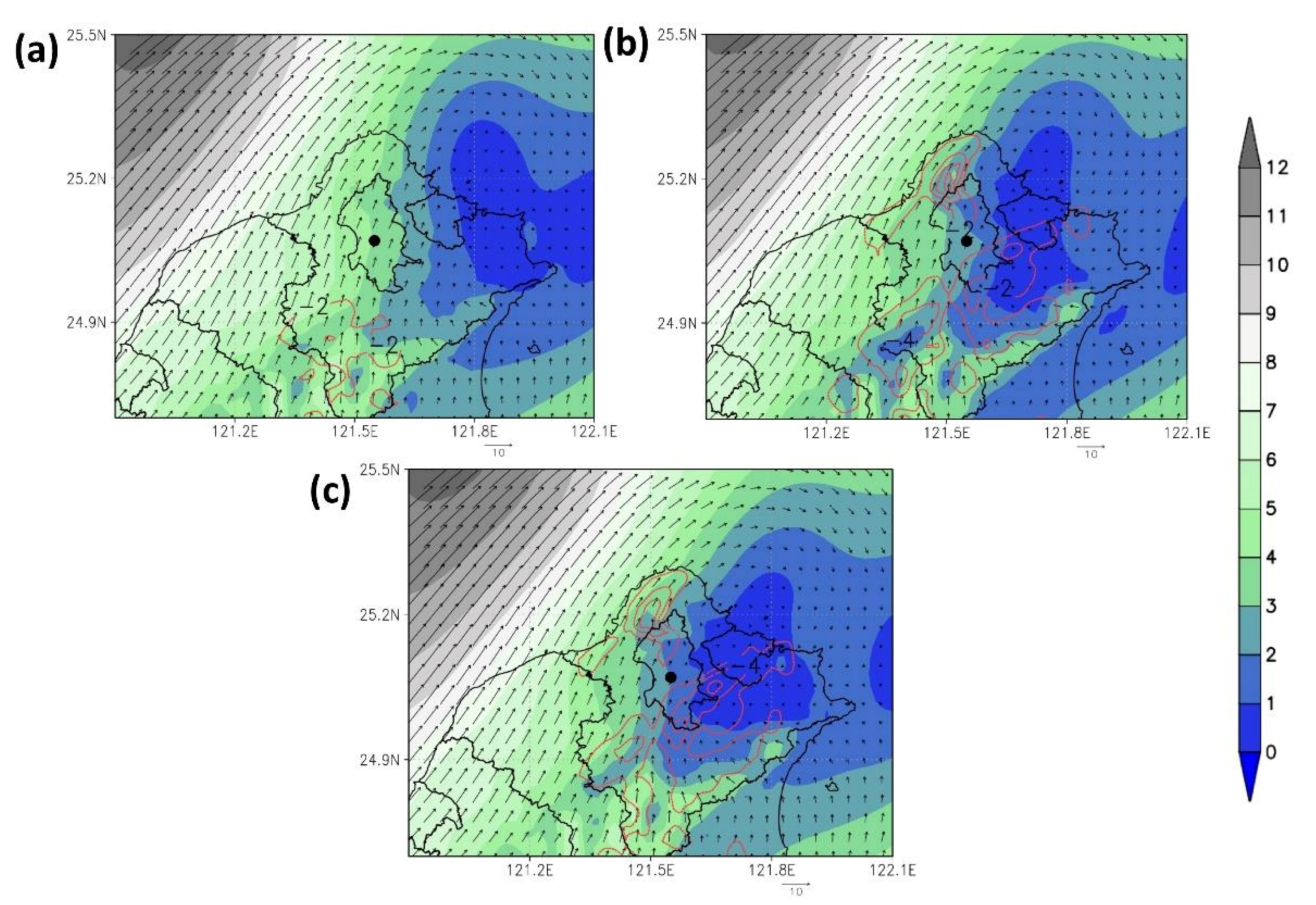
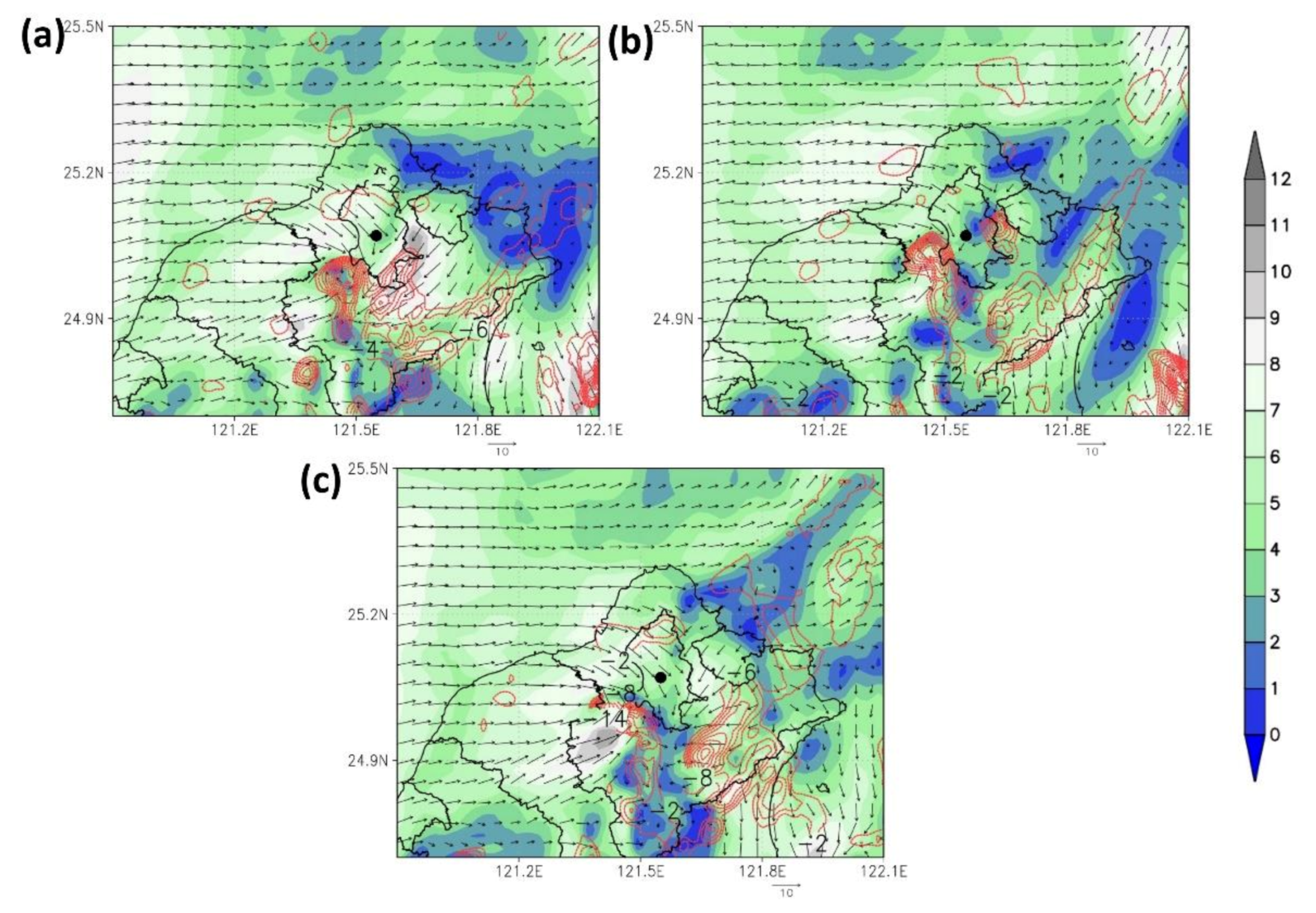

| Model Experiment | Description |
|---|---|
| WRF-GSI | The 15 km WRF-GSI hybrid data assimilation uses the NCEP GDAS obs database. The DA period is every 6 hr initialized from 06/02 0000UTC to 06/04 0000UTC. The forecast is hourly output and provides ICBCs to 3 km experiments. |
| WRF-GSI_noDA | The 3 km cycling forecast started from 06/02 0000UTC to 06/04 0000UTC. All ICBCs from 15 km WRF hourly forecast. Deterministic forecast performed on 06/04 0000UTC for 24 hr. |
| WRF-GSI_lidar | Same as “noDA,” but using a 3 km 3DVar assimilated Songshan Airport lidar data every 1 h cycle until 06/04 0000UTC. The hzscl_op (3) = [0.09325,0.1865,0.375] |
| WRF-GSI_lidar_hzscl | Same as “lidar” with 3 km resolution but reduces hzscl_op(3) parameter 1/2. The hzscl_op (3)= [0.046625,0.09325,0.1875] |
Publisher’s Note: MDPI stays neutral with regard to jurisdictional claims in published maps and institutional affiliations. |
© 2022 by the authors. Licensee MDPI, Basel, Switzerland. This article is an open access article distributed under the terms and conditions of the Creative Commons Attribution (CC BY) license (https://creativecommons.org/licenses/by/4.0/).
Share and Cite
Chen, C.-Y.; Yeh, N.-C.; Lin, C.-Y. Data Assimilation of Doppler Wind Lidar for the Extreme Rainfall Event Prediction over Northern Taiwan: A Case Study. Atmosphere 2022, 13, 987. https://doi.org/10.3390/atmos13060987
Chen C-Y, Yeh N-C, Lin C-Y. Data Assimilation of Doppler Wind Lidar for the Extreme Rainfall Event Prediction over Northern Taiwan: A Case Study. Atmosphere. 2022; 13(6):987. https://doi.org/10.3390/atmos13060987
Chicago/Turabian StyleChen, Chih-Ying, Nan-Ching Yeh, and Chuan-Yao Lin. 2022. "Data Assimilation of Doppler Wind Lidar for the Extreme Rainfall Event Prediction over Northern Taiwan: A Case Study" Atmosphere 13, no. 6: 987. https://doi.org/10.3390/atmos13060987
APA StyleChen, C.-Y., Yeh, N.-C., & Lin, C.-Y. (2022). Data Assimilation of Doppler Wind Lidar for the Extreme Rainfall Event Prediction over Northern Taiwan: A Case Study. Atmosphere, 13(6), 987. https://doi.org/10.3390/atmos13060987






